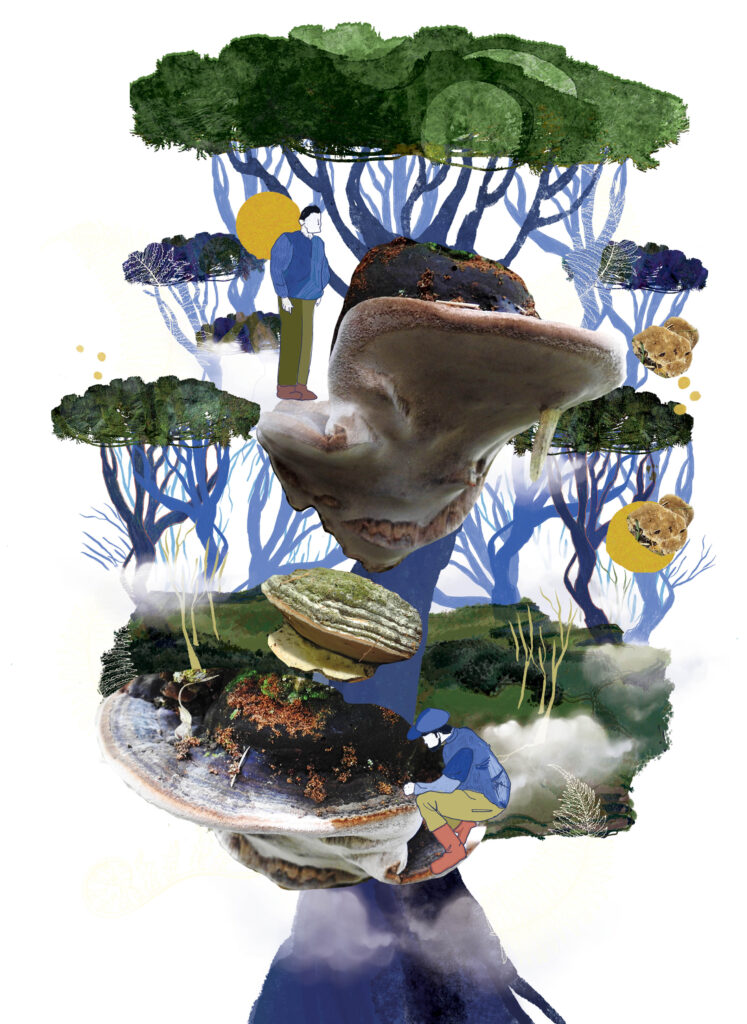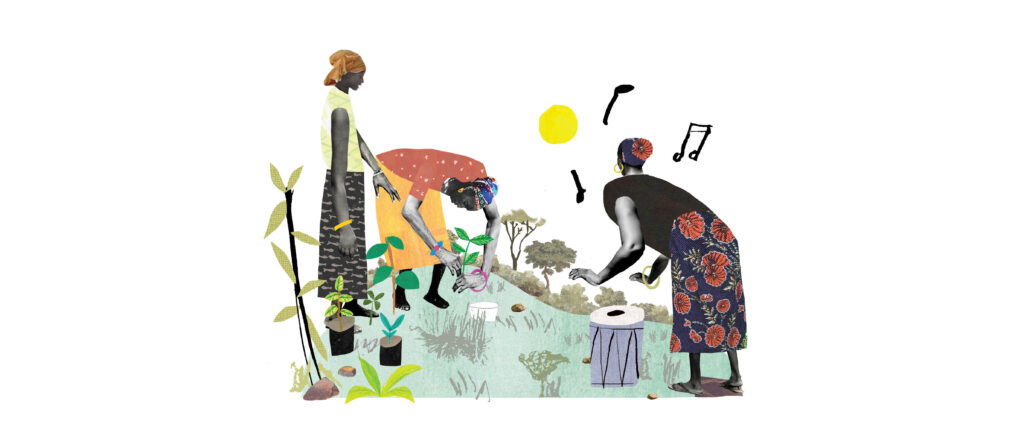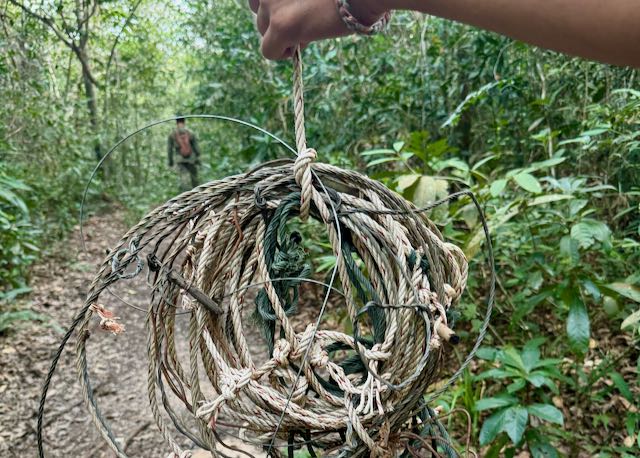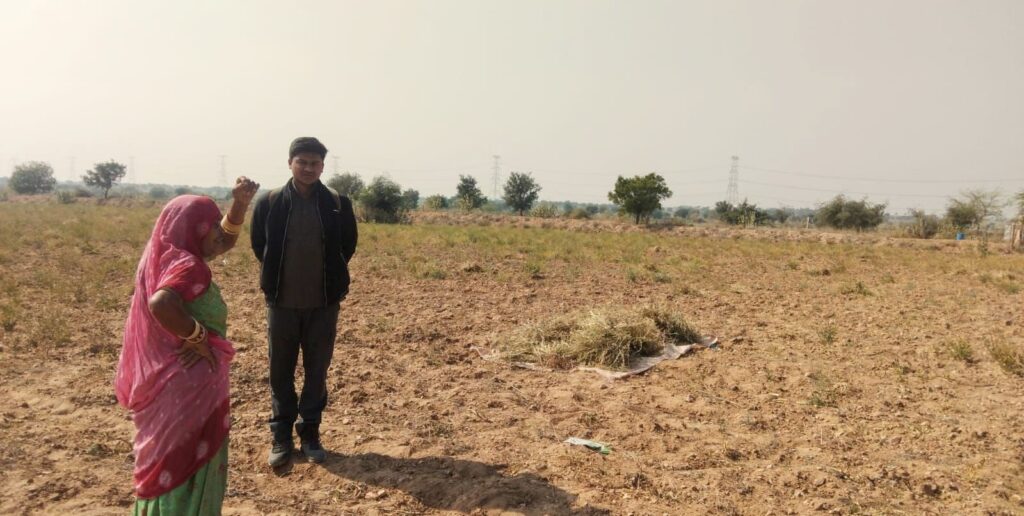Note: This is an artistic rendering of fungi and their habitats, and is not intended to represent any specific species or habitats.
The blazing sun beat down on our backs as we knelt over a dry mound of earth in the village of Sadolpara, nestled in the heart of Meghalaya’s West Garo Hills. Nikre, a diminutive woman whose frame belied her powerful presence, dragged her sickle across the top layers of the mound to reveal indents. She bowed her head, speaking with barely concealed anguish. “This is where we find the dambongg (mushrooms)—gifts from our Creator. But this year, there is no rain. The dambongg are rotting underneath the earth.” With those words, she walked on with her bamboo foraging basket, as large as her and conspicuously empty.
We—Malavika and Prithvi—were staying in Sadolpara, graciously hosted by village elders Nikre and her husband Sotging. With a population of around 800, Sadolpara is one of the last remaining bastions of Songsarek, the local religion. As a part of the Fungi Foundation’s Elders Programme, we were there to learn about their relationships with fungi—from traditional foraging practices, recipes handed down over generations, and even their use of yeasts to brew bitchi, a fermented rice beer central to their spiritual and cultural practices.
The Elders Programme strives to bridge the gap between generations and preserve the ecological knowledge that is passed down through the ages. The continuation of this knowledge, concerning the relationships between human beings and fungal species, is at risk as social and environmental changes erode generational traditions.
The preservation of this ethnomycological knowledge is more than a cultural endeavour; it’s a vital strategy for climate resilience. This ancestral knowledge serves as a living map, guiding communities through changing environments with time-tested practices. As climate shifts alter familiar landscapes, the insights passed down through generations become invaluable tools for adaptation. Moreover, this knowledge embodies a profound connection to the land, teaching sustainable harvesting methods that maintain ecological balance. By safeguarding and passing on ethnomycological traditions, we aim not only to preserve the past, but also to equip future generations with the skills to navigate an uncertain climate future, rooted in ancestral wisdom.
Observation through absence
When we had first visited Sadolpara the previous winter to introduce ourselves and our work, Sotging and Nikre excitedly told us about different mushrooms they eat, such as dambongg. In A·chikku, the local language, dambongg is the word most commonly used for mushrooms belonging to the genus Termitomyces—a unique genus of fungi that are cultivated by termites, in elaborate subterranean fungal combs. The termites cultivate this fungus to help them digest plant matter, and have no use for the mushrooms that it produces. Those mushrooms, the dambongg, are instead harvested by people like Nikre and her family. Though Termitomyces species are the most prized edibles in the region, they are far from being the only ones consumed. They also told us about bol nachal (which translates to ‘wood ear’), a species from the Auricularia genus, and wa·gambal, an edible species from the Lentinus genus.
During this visit, however, the region was experiencing an extreme heatwave. Ordinarily, May would bring regular pre-monsoon showers to soak the earth and enable mushrooms from the Termitomyces genus to emerge. But as we walked the regular foraging routes with our guides, their faces reflected the bleak landscape.
“The dambongg would have been here,” Nikre muttered, the crack in her voice mirroring the cracks in the parched earth. Deeper in the jungle, she gathered roselle leaves and banana flowers, describing how she would cook them with mushrooms—if any were found.
Back in the nok-A·chik, the traditional thatched grass house, we listened to Nikre and Sotging talk about how the forests had changed since their childhoods. “The gods are angry with us, because we don’t practise Songsarek the way we used to,” Nikre lamented.
“When our ancestors came, they took care to preserve the traditions and not a single seed was lost, but no more,” the pain in Sotging’s voice is evident. He narrated the Songsarek creation myth for us once again. Nuru Mande, the first human, followed divinities as they rose through seven layers of the earth. He mimicked their songs and their dances, learning their ways to honour the land. In a community so deeply rooted in the cycles of the land, it stands to reason that the changing of culture is seen as inextricably linked to the changing of forests.
As Nikre passed us a gourd of bitchi, we were reminded that our aim is to understand the multiplicity of relationships between native communities and their landscapes, ensuring they have a voice in the larger conversations around fungal conservation.
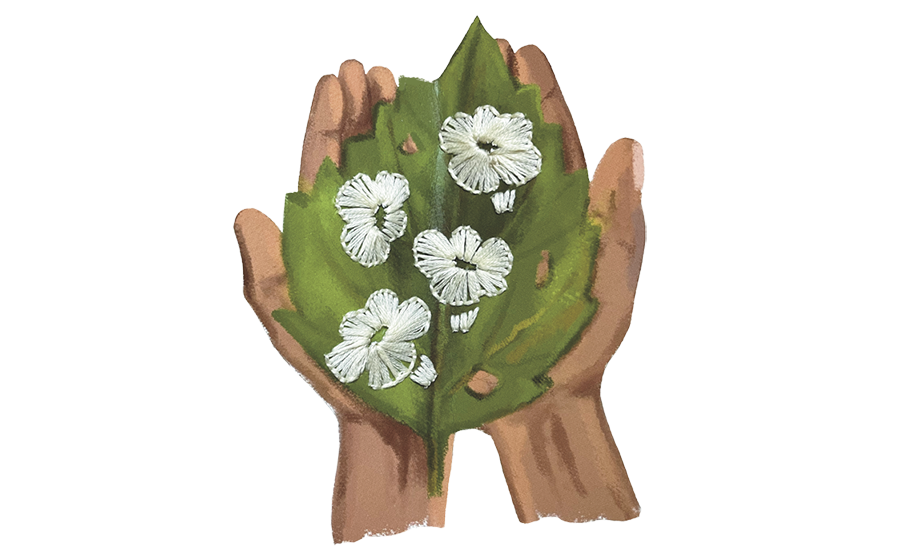
Sustaining generational practices
The following week, we watched the landscape transition as we travelled from the Garo Hills to the Khasi Hills. In contrast to the former’s subtropical to tropical climate, the Khasi Hills experience a more temperate climate in higher altitudes and a subtropical climate in lower regions, fostering lush evergreen forests, montane grasslands and subtropical pine forests. Areas such as Mawsynram and Sohra in the Khasi Hills have long held the title of ‘wettest place on earth’, but here too, heatwaves have become more frequent.
In a young forest near Miarang in the Khasi Hills, we walked through Pinus kesiya trees with Kong Queency Thiangkhew and her group of elder foragers. Kong Queency is worlds apart from Nikre—a devout Christian woman and a retired horticulturist, she forages not for subsistence but for the pleasure of the act itself. Over the years, she has gathered a group of nearly 20 women, who collect only enough mushrooms for their own kitchens and to share with their friends, keeping this traditional practice alive.
The Khasi name of each of the species refers to its shape. For example, tit thnat syiar means ‘chicken foot mushroom’ and refers to the chicken-foot shape of the Clavulina species. The prized Turbinellus floccosus is called tit tyndong, referring to its funnel-like shape. The foragers rattled off a dozen different names, as we scrambled to note them down.
Picking up a massive specimen of Neolentinus lepideus, Kong Queency beckoned us over for a lesson. “You see, before the monsoon, the mushrooms are full of poison, even the edible ones,” she explained. “When the rain is intermittent, the ground is full of snakes and insects, who bite the mushroom and leave their poison in it. That’s why we wait for the storms—the thunder and lightning imbue the mushrooms with vitality, and the rain washes out the poison.”
Kong Mem, another forager explained that when they were children, such lessons about identifying edible and poisonous mushrooms were a part of daily life in the monsoon, especially for the women of the home. They went into the forests with their mothers and grandmothers, learning how to identify around 30 different edible species. But with the changing economic landscapes, younger generations are no longer able to learn and practise these traditions. Without the wisdom of generations, many fall into the trap of misidentifying poisonous species as edible ones.
A recent spate of poisonings was one of the reasons we had come to learn more about the traditional methods of mushroom identification. In the face of climate catastrophes that can leave communities isolated and cut off supply chains, traditional knowledge of wild foods is a lifeline. Yet, it is in those desperate times that people are most vulnerable to misidentification and subsequent poisoning. That’s why the preservation and continuation of such oral traditions are so important.
On our drive back to Shillong, Kong Queency gazed wistfully at the pines that rushed past us. “Every year, the forest shrinks…” her voice was barely above a whisper. “Logging is ruining our traditions.” With these words, the joy that usually emanates from Kong Queency took on a poignant tinge. Illegal logging, particularly for charcoal production, has become a severe threat to the forest cover and environment in the West Khasi Hills district. The region is a hotbed for the illegal charcoal mafia, producing and transporting over 6000 tons of charcoal annually. This rampant felling of trees, including pine, for charcoal-making has led to a reduction in forest cover, loss of biodiversity and habitat fragmentation.
Though she has cultivated a foraging practice steeped in leisure, the grief of losing the landscapes that sustained the generational tradition of foraging is clear in her voice. To Kong Queency, the felling of trees is more than the degradation of biodiversity—it’s the destruction of a multi-species relationship between the pines, the mushrooms, and the communities that rely on them.
“These days, young people don’t have time to learn foraging. Even my children don’t have time—they are busy with their jobs. That’s why I keep going, keep teaching others,” Kong Queency tells us. Despite the changes all around her, she is determined to protect the practices of her ancestors, and we are privileged to be allies in her efforts.
Indigenous wisdom influences scientific inquiry
Reflecting on our experiences in the Khasi and Garo Hills, we are humbled by Kong Queency’s unwavering passion and the resilience of the residents of Sadolpara. They both serve as poignant reminders of the importance of integrating indigenous perspectives into scientific inquiries. After all, the depths of the inter-species relationships cultivated by cultures like the Garo and Khasi place India in a unique position. Unlike the West, where ethnomycological practices are being revived after being nearly lost, cultures around India are at a transition phase where these traditions need to be sustained rather than rediscovered.
Documenting and preserving this indigenous knowledge is therefore not only an academic exercise, but also an attempt to cultivate new perspectives on conservation that shape our future actions. Given that mycology is a relatively young science, an interdisciplinary approach such as this one may offer us a path to better comprehend the intricacies of fungal relationships with other species.
By integrating ancient wisdom with modern academic knowledge, we can ensure these invaluable traditions continue to thrive, enriching our understanding and guiding our conservation efforts. In doing so, we aim not only to preserve the past but also to equip future generations with the skills to navigate an uncertain climate future, rooted in ancestral wisdom.
Further Reading
Gogoi I, A. Borthakur and B. Neog. 2023. Ethnomycological knowledge, nutritional and nutraceutical potential of wild edible macrofungi of Northeast India. Studies in Fungi 8:12.
Karlsson, B. G. 2011. Unruly Hills: A Political Ecology of India’s Northeast. Oxford: Berghahn Books.
Villani M., C. Moreno and G. Furci. 2023. Ethnomycology Ethical Guidelines. Fungi Foundation.

